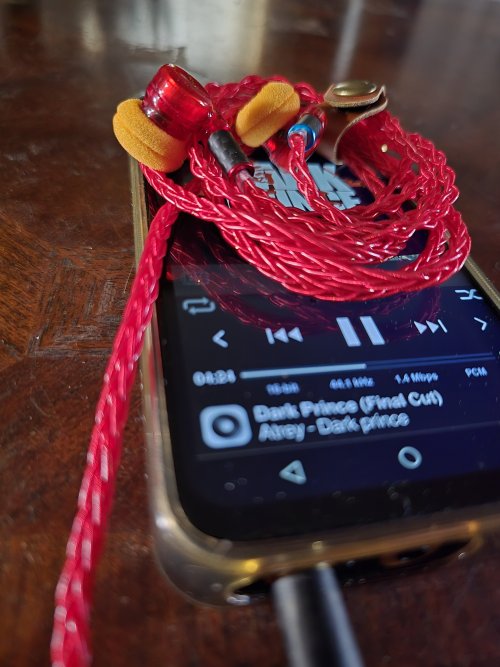IEMs & TWS: Sound Rhyme (SR8, SR5), Night Oblivion Butastur, Softears RSV, Sennheiser IE600, EPZ 530, Aful Performer 8, Dunu (SA6, Titan S), Mangird (Tea 2, Tea), Moondrop (B2D, Aria, SSP, Chu), ISN (H50, H40), Penon (Serial, Fan 2), 7hz (Timeless, Zero), AZ A7, Tanchjim Oxygen, Audiosense (DT600, AQ4, DT200), Juzear 41T, SeeAudio Midnight, Tangzu (Wu Zetian, Yuan Li, Wann’er), Shuoer S12, Ikko OH10, Tin Hifi (P1 Max, P1+, T4, T3+, T2+), Tripowin (Olina, Mele), BQEYZ (Autumn, Spring 2), TRI (Starsea, Meteor, Kai), Fiio FHE, TruthEar (Hexa, Zero, Hola), Simgot (EA500, EW200), Sony MDR-EX800ST, Hiby Seeds 2, Smabat Proto 1.0, TFZ No.3, Whizzer HE-01, Reecho SG-01, HZ Heart Mirror, Kiwi Ears Cadenza, Kbear Rosefinch, Geekwold GK10, TRN BA5, QKZ x HBB, Blon (BL05s, BL03), KZ (CRN, DQ6s), CCA CRA / Technics AZ-60, Fiio FW5, Soundcore (L3P, L4 NC), M&D MW07+, Bose QuietComfort II, Tanchjim Echo, Moondrop (Sparks, Space Travel), Tin Hifi Buds 3, Jabra Elite Active 75t, Samsung (Galaxy Buds2 Pro, Galaxy Buds Pro), AKG N400, Fiil T2 Pro, Earfun Free Pro 2, Sabat E12 Ultra, AirPods Gen 2, Soundpeats (Air4 Lite, Air3 Deluxe HS, Air3, Truair 2+), QCY T13
Buds & Headphones: TGXear (Black Sand Desolation Sound 4.4mm, Sunniva 4.4mm, Totem MX500 4.4mm, Totem Bell 4.4mm, Ripples 4.4mm, Black Sand Serratus 4.4mm, OG Serratus 4.4mn, Tantalus 4.4mm, Alpha 4.4mm), VE (Sun Copper 4.4mm, Zen SL 4.4mm, Zen 3.0 4.4mm, Asura 3.0 4.4mm, Zen 2.0 4.4mm, Monk Pro Vita 4.4mm, Monk V2S 4.4mm, Monk SM 4.4mm, Monk+ 3.5mm), Rikubuds (Grand Alter Saber 2 4.4mm, Grand Berserker 2 4.4mm, Grand Rider 1 3.5mm, Grand Archer 1 4.4mm, Saber 3 4.4mm, Alter Rider 3 4.4mm, Lancer 3 4.4mm, Berserker 3 4.4mm, Lancer 1 3.5mm, Berserker 1 3.5mm, Alter Rider 1 3.5mm, Alter Archer 1 3.5mm), Yincrow (RW-3000 MMCX, RW-2000 MMCX, Rhino MMCX, Calf MMCX, RW-9 3.5mm, X6 3.5mm), Moondrop Chaconne 4.4mm, Blur (Blur 189 Hybrid PK150 White Wraith LE 4.4mm, 266 PK32 3.5mm, 189 Hybrid MX150 aPS 4.4mm, 266R MX400 non-aPs Reference 4.4mm), Yinman 600 4.4mm, Ks (DB1 2-pin, K300 Samsara 4.4mm, LBBS 3.5mm), Fiio (FF5 MMCX, FF3 modular, FF1 2-pin), Lrey W03 Pro MMCX, Shozy BK 4.4mn, NiceHCK (EBX21 MMCX, EB2S 3.5mm, B70 3.5mm), Toneking Dendroaspis Viridi MMCX, Dunu Alpha 3 4.4mm, Smabat (M3 Pro, M2s), Faael (Rosemary, Snow Lotus Balanced, Iris 2.0), DQSM Panda PK2, NS Audio LCP 80 Copper MMCX, Lun Sheng Aeolian Bells MMCX, Qian (69 3.5mm, 39 3.5mm, Fengru (QGM S300 Black Lotus, EMX500S 3.5mm) / AiAiAi TM-2 Wireless Studio, Hifiman HE400i 2020
Sources: Fiio M11 Plus, iFi Gryphon, Topping G5, Cayin RU-6, Questyle M15, iFi xCan, GAD ADV, Khadas Tea, DDHifi TC44 Pro, Tanchjim Space, Truthears Shio, VE Megatron, Tmikoo 3.6" X15, Hiby R2, Hilidac Atom, Tempotec Sonata HD Pro, VE Abigail Pro 4.4mm / Hisense Touch / UA Apollo X8, UA UAD-2, UA Apollo Twin X Mk2, Motu Ultralite Mk5, Focusrite Clarett, Motu M4 / Topping PA5, SMSL DA-9, Topping PA3s / Topping A90D, Feliks Audio Elise + Psvane CV181-TII, Xduoo TA-20 Plus, Singxer SA-1, SMSL SH-9, Topping L30, Xduoo MT-602, ART Pro 6, Behringer Monitor2 / Gustard X16, SMSL SU-9, Topping E50, Khadas Tone 2 Pro, Topping D10 Balanced
This probably was in stock for ages. I only use Hiegi or K's foams, so there's no problem.




























